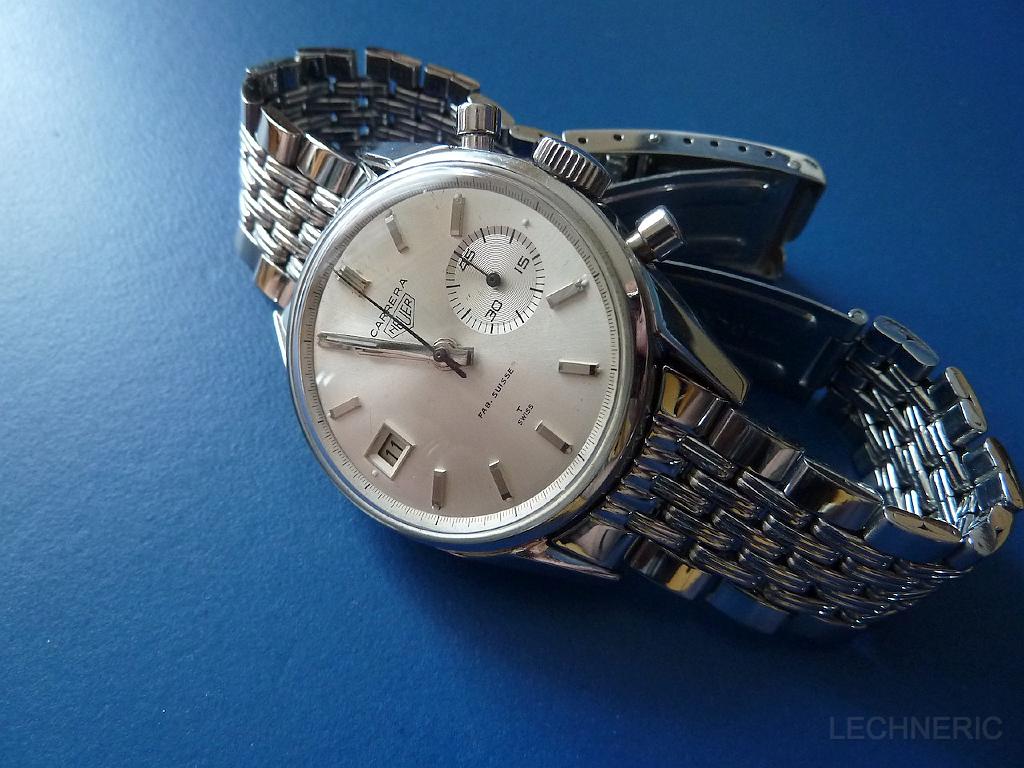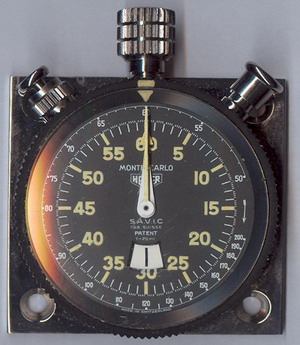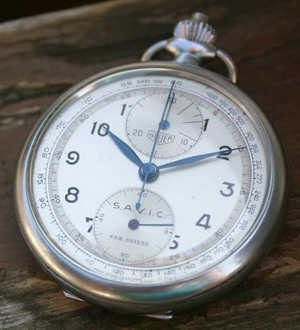Day One – Monday, June 13, 2011
One of the neat things about this vintage watch collecting hobby is that there is always something new to explore, some mystery to try to solve. We see a number in a catalog (1163P), some strange mark on a movement (SX) or dial (T), and rather than letting it go, every once in a while, there is the sudden urge to unravel the mysteries of the mid-20th century.
And so it was on the morning of June 13, 2011, when a forum participant posted a photo of his Carrera 45 Dato, seeking information about the year of production for the watch. That question was relatively easy, but suddenly I focused on two words written on the dial, comprised of nine letters, that I had seen hundreds of times before, but never bothered to explore . . . the words, “Fab. Suisse” (the abbreviation for the French term “Fabrique Suisse”, meaning “produced in Switzerland”).
Once upon a time, collectors of vintage Heuers used to say that Heuer dials were not supposed to include extra letters or words on the dial to indicate the number of jewels (for example, 17 rubis), or that the watch was shock-proof or used the incabloc shock-proofing system. The words “Fab. Suisse” caused similar suspicion, and collectors seemed to suggest that the appearance of this mark on the dial called into question the authenticity of the watch.
On the morning of June 13th, however, the words “Fab. Suisse” were on the dial of a beautiful Carrera, that appeared to be original in every respect. So I began to wonder, “How did these words get onto this dial?” Surely this beautiful Carrera 45 Dato had not been produced from some lesser watch (like a Baylor, Tradition or Zodiac), with the dial refinisher leaving the “Fab. Suisse”, but adding the “Heuer” and the “Carrera” so perfectly. How many 45 Datos were there that could have served as donors for this dial? Not many! And so, in an instant, I told myself that this Carrera was original, and that the “Fab Suisse” must have gotten onto the dial through legitimate production.

And thus the question, “Why do some Heuers from the 1950s and 1960s have the words “Fab. Suisse” on the dial? I decided that, after collecting the Heuers for around 10 years, June 13, 2011 would be the day that I finally did some digging and answered this question. To aid in my search, I would raise the question in a couple of discussion forums, and also post a more generic version of my question on Twitter — Why are the dials of some vintage Swiss watches marked “Fab. Suisse”, when they are already marked “Swiss” or “Swiss Made”? Surely, within a few minutes, I would have a definitive answer to this simple question. In the meanwhile, I would try a couple of quick Google searches. Surely, someone had written on this point.
To my surprise, over the course of the day, I received not one answer, but three answers . . . three very different answers!
First Theory – “Fab. Suisse” as a Marketing Device. According to one explanation – posted on a discussion forum — in the era after World War Two, the Swiss watch companies sought to capitalize on their reputation for high quality watches by indicating on the dials of their watches that they had been made in Switzerland. But this explanation made little sense to me: Why would a dial be marked both “Swiss” and “Fab. Suisse”? Surely the marketing types would have realized that the word “Swiss” conveys the same sense of quality as “Fab. Suisse”, so this would not be a good reason to clutter up the dial with both phrases. OK, so we reject this explanation.
Second Theory – “Fab. Suisse” Required in France. A second explanation suggests that in order to be sold in France, during a certain historic period, a watch was required to state its country of origin in the French language. The usual “Swiss” or “Swiss Made” – routinely printed on the dial by the manufacturer — would not satisfy this requirement, as these are English phrases, rather than French phrases. Under this theory, the French importer (or the brand sending the watch into France) would add the “Fab. Suisse” marking to a standard dial, which explains why the same dial would have the word “Swiss” as well as the “Fab. Suisse” marking. This theory seems to be the “conventional wisdom” on the subject. Here is a thread from the HOrological MEanderings discussion forum that supports the theory.
Third Theory – “Fab. Suisse” Required in Canada. Theory number three is exactly the same as theory number two, except that it is Canada (or more specifically the Province of Quebec) that is imposing the French language requirement. This theory has the merit of simplicity, but I wonder whether all the watches that we see with the “Fab. Suisse” marking could actually have been sent into the Canadian market? So my conclusion is this explanation is theoretically sound, but I doubt that it explains the reality that we see in the vintage watch world. Simply, there could not have been this many watches produced for Quebec (or even all of Canada).
End of Day One – We Have a Theory, but No Definitive Proof. As Day One of my one-hour research project came to a close, I had a theory [required by French law], which seemed like the best explanation, but I was frustrated that we didn’t have a definitive answer, from an expert, supported by chapter and verse of a specific regulation. How the Internet has spoiled us. A few years ago, this type of inquiry would have involved time-consuming research in original materials, at some distant library. Now, we are upset when we can’t find black-and-white answers to esoteric questions, within the timeframe of a couple of Google searches and discussion forum postings.
Day Two – Tuesday, June 14, 2011
Day Two of my search for Fab. Suisse began in the dentist’s chair, at 8:00. The Novocain numbed my mouth, the questions about Fab. Suisse numbed my brain, and I stared at a poster on the dentist’s wall, that had the following quotation:
I fully realize that I have not succeeded in answering all of your questions. Indeed, I feel I have not answered any of them completely. The answers I have found only serve to raise a whole new set of questions, which only lead to more problems, some of which we weren’t even aware were problems. To sum it all up…In some ways I feel we are as confused as ever, but I believe we are confused on a higher level, and about more important things.
OK, that poster was surely a sign: We would not be able to find an answer to the Fab. Suisse question, but at least we had learned a few lessons along the way.
Things went from their proverbial “bad to worse”, when I got to my office and had a quick e-mail exchange with Mr. Jack Heuer, the President of Heuer-Leonidas during the 1960s and now Honorary President of TAG Heuer. If anyone could confirm one of the theories from Day One, it would be Mr. Heuer. So I served up the question about Fab. Suisse, and even provided a selection of possible explanations. Mr. Heuer responded by expressing his doubts about the “required by French law” explanation, while also not providing any other better explanation. Indeed, it seemed that this question would have no answer. If Mr. Jack Heuer could not provide the answer, then what could any mere mortal hope to achieve!
If this were a detective show, we would say that the first real “break” in the investigation came at around 2:00 in the afternoon, when “nickd” posted a message — with the title, “You owe me a beer” — on the HOrological MEanderings discussion forum, that included the following language from a French statute, circa 1936:
Douanes Marque « Fab. suisse »
Les exportateurs sont rendus attentifs aux décisions qui ont été prises par l’Administration des douanes françaises, concernant l’apposition du correctif d’indication d’origine pour les produits horlogers. Le correctif « fab. suisse » doit être apposé, toutes les fois que la place existe, aussi près que possible de la marque elle-même, à côté ou immédiatement au-dessus ou au-dessous. Seules les petites pièces, où un manque de place empêche d’apposer le correctif conformément aux décisions ci-dessus, pourront le porter au-dessous de 6 heures. En vue d’éviter des difficultés et voir des cous refoulés, les exportateurs voudront bien se conformer aux indications ci-dessus.
Nickd was good enough to provide the following translation:
Customs Label “Fab. Suisse”.
Exporters have become attentive to the decisions that have been taken by the Administration of the French customs concerning the placing/fixing of the place-of-origin markings for horological products. The markings “fab. suisse” must be placed, whenever space allows, as close as possible to the make itself, to the side or immediately above or below. Only small watches, where a lack of space prevents the placing of the markings in accordance with the above instructions, can have it below the 6 marker. In order to prevent difficulties and the return of packages, exporters would do well to conform to the above mentioned instructions.
So there we have it: The “Fab. Suisse” marking is, in fact, a “customs label” that French authorities required on the dial of Swiss watches being imported into France. Rather than being a marketing tool or badge of honor for the high quality Swiss watches, the “Fab. Suisse” was a warning that the watch had been made in Switzerland, rather than in France. [Kind of like requiring that any Toyota or Honda coming into the United States bear the badge, “Made in Japan” placed as closely as possible to the “Toyota” or “Honda” badge, on the face of the car. This analogy is probably more realistic than we first imagine, as the Swiss watch industry in the late 19th / early 20th century was thought of in much the same was as the Japanese watch industry in the late 20th century.] Questions remained, but it certainly seemed that we had the answer!
Case Closed!!
Continuing with the language of detective dramas, we can say that it was “case closed” for the mystery of the Fab. Suisse, late Tuesday night. “Marv” posted a fantastic message — entitled, “For Consumer Protection” — on the HOrological Meanderings discussion forum, that provided a complete history of the French requirement for the “Fab. Suisse” marking, with this history dating from 1892 [that’s right, 1892, one hundred and nineteen years ago]. Marv showed watch dials from Jaeger, Omega and Longines, from the 1930s, 40s, 50s and 60s, all with the “Fab. Suisse” on the dial. Indeed, French authorities required that the dials of Swiss watches clearly marked with the words “Fab. Suisse”, to warn French consumers of their origin. (Skeptics might also suggest that they were motivated to protect the French watch industry.)
At 12:40 AM, it’s too late tonight to attempt to paraphrase Marv’s amazing discussion forum posting — if you are interested in the “Fab. Suisse” story, then you should read Marv’s message, in its entirety. It’s also too late to try to wrap up all the loose ends of the “Fab. Suisse” mystery. I would like to create a webpage to tell the story, so that — with any luck at all — the next vintage watch collector wondering about these two little words will be able to put the words “Fab. Suisse” into a Google search, and find the answer . . . in a lot less than two days!
Thanks to “nickd”, “Marv” and all the OnTheDash regulars who played a role in the search for “Fab. Suisse”.
Comments and additional information will be welcomed! Write to me at OnTheDash@bellsouth.net
Afterwards – June 15, 2011
The day after we published the “Search for Fab. Suisse” posting, we continued to receive some additional information.
Mr. Jack Heuer sent an e-mail message, congratulating us for solving this little puzzle. He also confirmed that France had been a relatively small market for Heuer watches and chronographs in the 1950s and 60s, although the company was more successful in marketing its stopwatches and timers in that market.
The exclusive importer of Heuer watches in France over these decades was S.A.V.I.C. (which stands for something like “Societe Anonyme Vente Industrielle de Compteurs”, meaning that SAVIC focused on industrial stopwatches [perhaps comparable to Fisher Scientific, in the United States]). SAVIC was a strong importer for Heuer in the early years, but was less successful in selling the self-winding watches that became popular in the 1950s. Mr. Heuer remarked that Breitling was more successful than Heuer, in terms of selling watches and chronographs in France. The fact that Heuer sold relatively few watches and chronographs into the French market back in the 1960s explains why we see so few of the Fab. Suisse markings today.
Mr. Heuer’s description of SAVIC and its success in selling Heuer stopwatches and timers into the French market suggested another channel for research relating to the Fab. Suisse mark. Over the years, we have seen numerous stopwatches, pocket chronographs and dashboard timers that are co-branded “Heuer” and “S.A.V.I.C. I dug through my photo files and found a few photos of timepieces with the SAVIC name on the dial. Just as we might have expected, all these timepieces also had the Fab. Suisse marking on the dial.



It has been an interesting couple of days, exploring a topic that most of us had ignored for years. Stay tuned for further information and attention relating to the Heuer chronographs that were sold in France, with the Fab. Suisse mark.
/72Aut24461stEL.jpg)